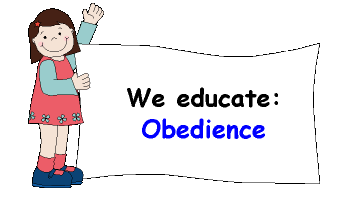|
The action of obeying is accepting norms, orders, rules and behaviours. An obedient person is the one who has the habit to obey. It is necessary to teach the child to obey the adults, because this obedience is part of the learning of the control and regulation of conduct, of the assimilation of rules, which will be assimilated first in an external framework, doing the things the adult says to please him, and to gain his approval and praise; and later, if the child is properly stimulated by the adult, by his own will, learning to control his conduct and to fulfil the rules in a conscious way, no longer to please anybody but for the satisfaction that this produces to him. From a very early age, the child will be taught to fulfil simple orders, which will get more complicated later, to the extent that his development allows him, because the socialization process is long and complex. Although it is necessary to teach the child to be obedient, this does not mean that we want a blind obedience, we must always explain why it is necessary that he does the things that are requested to him. In this block some activities are suggested to develop obedience, but in fact this is obtained through a systematic education in all the activities that the child does in the centre, for example: the free activities, the games, the processes of satisfaction of basic needs (cleanliness, bathroom, feeding, etc) and the educational activities. |
ACTIVITY
No 1 |
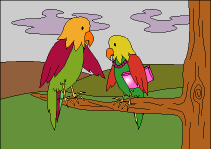 |
Summary of the activity: Firstly there will be a conversation to know what the children think about obedience, later we will prepare all the necessary things for the staging of a story and finally there will be a theatre play. Objectives: That the children know why they must be obedient with their parents and teachers. Procedures:
Material Resources: Cardboard, brushes, temperas.
Development of the activity: To
bring about this conversation the educator will tell the following
story: Do
you think that Rosita is obedient?
2nd Part
3rd Part He will reinforce the criteria that Tita could have died for being disobedient, the educator will tell the children that this is why he recommends that the children do not do what Tita did. Later he will tell them that on the following day or another day they will do a new activity over what happened to Tita. |
ACTIVITY
No 2 |
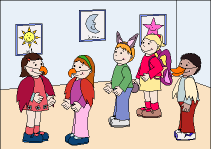 |
Summary of the activity: This is the continuation of the previous activity in which we reinforce what happened to the parrot in the story with some practical actions. Objectives: To reinforce the experiences on what happens when one is disobedient. Procedures:
Material Resources: Toy parrot after the storm. Art materials: cardboard, markers, temperas, brushes, among others.
Development of the activity: What do we need to stage the story?, he will ask and the children will answer, for example: To paint a tree, a lagoon, the grey clouds, the masks for the different little animals, the wings of the butterfly, the ears of the rabbit, the feathers of the parrots, etc. With the help and direction of the educator, a group will be in charge of painting and cutting to prepare the stage, another group will make the masks and disguises necessary to represent the little animals.
2nd Part A girl would represent the role of the parrot mother, another girl the role of Tita, a boy will be the little rabbit, a girl the butterfly, and a boy the duck. Each one will learn the part of the story that he has to act. The
story will be represented and when it is done, the educator will congratulate
the children for the work done and he will ask them: He will let the children express themselves freely and will emphasize the need for children to be obedient with their parents, teachers and other adults. The criterial eevaluation will be done together for both activities. |
CRITERIAL
ASSESSMENT |
|||
Observed
conduct |
YES |
NO |
Comments |
At
the beginning they had very little knowledge on obedience. |
|||
The
children have understood what is an obedient behavior. |
|||
They
have understood the benefits of acting obediently. |
|||
They
have learned the damages that a disobedient conduct can cause. |
|||
They cooperated in the representation of the drama expressing how good
it is to be obedient. |
|||
ACTIVITY
No 3 |
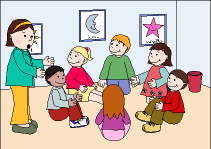 |
Summary of the activity: This is a motion game, in which the children will rise, walk, stop and turn. Objectives: Procedures:
Material Resources: xxx
Development of the activity:
This is repeated two or three times. The obedient children who follow
the rules of the game will be named. The rules are: |
CRITERIAL
ASSESSMENT |
|||
Observed
conduct |
YES |
NO |
Comments |
They
fulfilled well the order to do the movements. |
|||
They
needed help to carry out the order to accomplish the movements. |
|||
They
made an effort to be declared obedient in the game. |
|||
They
felt satisfaction to be the winners in the game. |
|||
They verbally expressed how good it is to be obedient.
|
|||
ACTIVITY
No 4 |
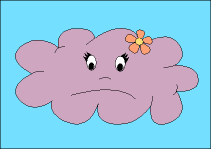 |
Summary of the activity: The educator will recite a poem to the children and later they will talk about the content, and finally they will draw. Objectives: To develop in the children experiences on the damage of being disobedient. Procedures:
Material Resources: Colour pencils, paper, brushes and temperas.
Development of the activity: Here the educator says a poem about a little blue cloud that did not obey her mother and was trapped by some very dark storm clouds that wanted to take her beautiful blue colour away from her. After
listening to the poem, the educator groups them around him in an
informal way and he asks them to give their opinions: "Now
you are going to tell me: To reinforce the moral of the story "Sometimes the sky is full of great grey storm clouds and the clouds lose their blue tone, but if the little cloud had paid attention to the wind, this would have blown it away and she would have escaped the storm clouds that wanted to take her blue color".
2nd Part Later the drawings will be exhibited in the mural of the classroom and they can be used to tell stories of the rain tale. |
CRITERIAL
ASSESSMENT |
|||
Observed
conduct |
YES |
NO |
Comments |
They
knew how to explain why the little cloud lost its blue colour. |
|||
They
showed satisfaction with the activity. |
|||
They
were interested in drawing the content of the poem. |
|||
They
verbally expressed favourable opinions about obedience in a spontaneous
way. |
|||
ACTIVITY
No 5 |
 |
Summary of the activity: The activity consists of the dramatization of a poem. Objectives: To give the children knowledge on the damages of disobedient conduct. Procedures: Dramatization. Material Resources: Little green costumes and masks of frog and little toads.
Development of the activity: The educator will narrate the poem, a girl will be the mother frog and a child the little toad. The child who plays the role of the little toad will jump in a pool drawn on the floor, he will pretend to fall, and he will make expressions of pain and grief.
2nd Part The answers can be recorded so that later in an independent activity or a free game they can listen to them. |
CRITERIAL
ASSESSMENT |
|||
Observed
conduct |
YES |
NO |
Comments |
They
knew how to explain the conduct of the character. |
|||
They
needed help to explain the conduct of the character. |
|||
They
evaluated the disobedient conduct of the character as negative. |
|||
They
knew how to evaluate the damages of the disobedient conduct. |
|||
They expressed a desire to be obedient in a spontaneous way. |
|||
ACTIVITY
No 6 |
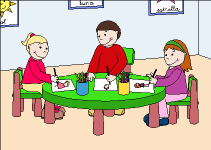 |
Summary of the activity: The educator will tell several stories that the children must complete and explain why they completed that way. Later he asks the children to draw themselves and to evaluate themselves as obedient or disobedient comparing themselves with the characters of the stories. Objectives: That the children learn to evaluate the obedient or disobedient conduct of others and their own. Procedures: Material Resources: Paper, pencils or markers.
Development of the activity: We ask the children to complete the story and explain why they completed it like that.
2nd Part
3rd Part |
CRITERIAL
ASSESSMENT |
|||
Observed
conduct |
YES |
NO |
Comments |
They
knew how to give the story a suitable ending. |
|||
They
needed help to give the story a suitable ending. |
|||
They
knew how to evaluate themselves as obedient or disobedient. |
|||
They
needed help to evaluate themselves as obedient or disobedient. |
|||
They expressed the desire to be obedient. |
|||


